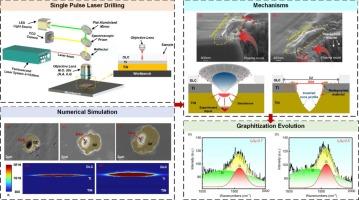Energy dissipation mechanism of femtosecond laser ablation of DLC/Ti/TiN multilayer heterogeneous films
IF 6.4
2区 工程技术
Q1 MECHANICS
International Communications in Heat and Mass Transfer
Pub Date : 2025-10-11
DOI:10.1016/j.icheatmasstransfer.2025.109822
引用次数: 0
Abstract
Ultra-hard multilayer heterostructured diamond-like carbon (DLC)/Ti/TiN thin films, featured by their unique multi-interfacial architecture and excellent wear resistance integrated with thermal impedance properties, have been developed as composite anti-friction and wear-resistant microfilms for complex working conditions. Femtosecond laser-controlled ablation has emerged as a key technology for precise micro-nano machining of such thin-film materials, with energy dissipation serving as the fundamental mechanism governing controlled ablation. However, the underlying physical mechanisms remain poorly understood. Herein, the femtosecond laser ablation of DLC/Ti/TiN films was investigated via integrated ablation experiments, multi-scale finite element modeling, and advanced characterization techniques (FIB, SEM, EDS), aiming to reveal the energy dissipation dynamics that govern material removal and structural evolution. Firstly, a proposed model simulates the energy transfer characteristics (deposition, absorption, diffusion) during femtosecond laser ablation and calculates the specific electron explosion force. For the first time, the energy distribution ratios among the three dominant interaction mechanisms (thermal conduction, plasma formation, and electron explosion force) are quantified. This quantification unveils their nonlinear dependence on laser energy. Detailed characterizations of inverted conical blind holes and diffusion zones confirm that plasma recoil dominates material ejection, while electron explosion forces drive interfacial delamination. The splashing morphology and crack propagation are correlated with recoil pressure gradients and Coulomb repulsive stress waves, and the redeposited particles at hole openings verify momentum dissipation during axial ejection. Furthermore, non-thermal mechanisms are identified to maintain structural integrity: Raman spectroscopy reveals graphitization of DLC without interfacial delamination, and EDS analysis confirms extremely low oxidation levels, as plasma-dominated material removal limits oxidation. As a result, femtosecond ablation induces only local phase transitions and minimal structural damage in multilayer films. Finally, this research provides a solid theoretical foundation for controlled femtosecond laser micro-nano manufacturing of DLC/Ti/TiN thin films, highlighting the critical role of energy dissipation dynamics in guiding process optimization and material design.

飞秒激光烧蚀DLC/Ti/TiN多层非均质膜的能量耗散机制
超硬多层异质结构类金刚石(DLC)/Ti/TiN薄膜以其独特的多界面结构和优异的耐磨性与热阻抗性能相结合,成为一种适用于复杂工况的复合抗磨耐磨微膜。飞秒激光控制烧蚀已成为这类薄膜材料精密微纳加工的关键技术,而能量耗散是控制烧蚀的基本机理。然而,潜在的物理机制仍然知之甚少。本文通过综合烧蚀实验、多尺度有限元建模和先进表征技术(FIB、SEM、EDS)对DLC/Ti/TiN薄膜的飞秒激光烧蚀进行了研究,旨在揭示控制材料去除和结构演变的能量耗散动力学。首先,该模型模拟了飞秒激光烧蚀过程中的能量传递特性(沉积、吸收、扩散),并计算了比电子爆炸力。首次量化了三种主要相互作用机制(热传导、等离子体形成和电子爆炸力)的能量分布比。这种量化揭示了它们对激光能量的非线性依赖。对倒锥形盲孔和扩散区的详细表征证实,等离子体反冲主导了材料弹射,而电子爆炸力驱动界面分层。溅射形貌和裂纹扩展与反冲压力梯度和库仑排斥应力波有关,孔口处的再沉积颗粒验证了轴向喷射过程中的动量耗散。此外,非热机制被确定为保持结构完整性:拉曼光谱显示DLC的石墨化没有界面分层,EDS分析证实极低的氧化水平,因为等离子体主导的材料去除限制了氧化。因此,飞秒烧蚀在多层膜中只引起局部相变和最小的结构损伤。最后,本研究为可控飞秒激光微纳制造DLC/Ti/TiN薄膜提供了坚实的理论基础,突出了能量耗散动力学在指导工艺优化和材料设计中的关键作用。
本文章由计算机程序翻译,如有差异,请以英文原文为准。
求助全文
约1分钟内获得全文
求助全文
来源期刊
CiteScore
11.00
自引率
10.00%
发文量
648
审稿时长
32 days
期刊介绍:
International Communications in Heat and Mass Transfer serves as a world forum for the rapid dissemination of new ideas, new measurement techniques, preliminary findings of ongoing investigations, discussions, and criticisms in the field of heat and mass transfer. Two types of manuscript will be considered for publication: communications (short reports of new work or discussions of work which has already been published) and summaries (abstracts of reports, theses or manuscripts which are too long for publication in full). Together with its companion publication, International Journal of Heat and Mass Transfer, with which it shares the same Board of Editors, this journal is read by research workers and engineers throughout the world.

 求助内容:
求助内容: 应助结果提醒方式:
应助结果提醒方式:


